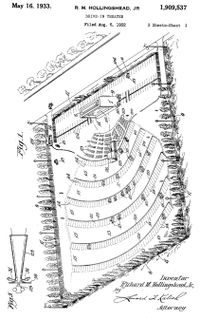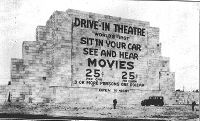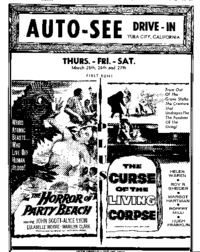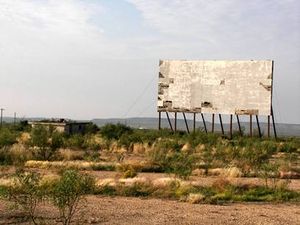Difference between revisions of "Drive-In Theater"
| Line 48: | Line 48: | ||
| − | + | The drive-in can be classified as a specific type of architecture: roadside architecture. Along with things like motels, truck stops, and gas stations, drive-in structures were built efficiently with little to no frills to minimize cost and maximize profit. “As a whole, roadside architecture has had a tremendous impact on the American landscape, especially evident in the array of forms, images, and colors that comprise the panoramic view from our windshields.” And their designs were so simple that building them cheaply wasn’t hard to do. There are four primary components to most theaters: the screen, the projector, the sound dissemination device and/or technique, and the viewing area. The screen could be anything from a white sheet to a professional grade, synthetic piece designed specifically for the drive-in. Concession stands were one other aspect that was a fixture at most theater. But as aforementioned, anything extra, like decoration or design elements, were added to increase profits. For instance, if a drive in’s sign featured an elaborate painting and lighting set-up, the only reason was so people on the highway would see it and exit to come check it out. | |
| − | + | ||
| Line 59: | Line 58: | ||
==The Baby Boom: Family Time at the Movies== | ==The Baby Boom: Family Time at the Movies== | ||
| + | |||
| + | One of the reasons thought to have contributed to the great success of drive ins in the mid 20th century was the fact that it merged two of the most prolific inventions of the era: the automobile and the motion picture. The drive-in was a mechanism for post World War II rebuilding of the American nuclear family. It was a wholesome locale where dad, mom, child #1 and child #2 could go and spend time together, bonding, but without too much actual interaction. The concept of the suburb is interesting because of its paradoxical components. Originally, people moved to the burbs for privacy, and to get the space that wasn’t available to them in the cities. But historically, suburbs have become hubs for community interaction. Ironically, people wanted to live their private lives, together with other people doing the same. The drive-in became analogous with that concept. The theaters allowed people to maintain a sense of security and anonymity, because they remained in the privacy of their own vehicle, but they had company of hundreds of other cars, also filled with people doing the same thing. | ||
Revision as of 19:38, 11 December 2010
Popular during the mid 20th century, a drive-in is an outdoor movie theater venue in which people sit with their cars parked in front of a screen to watch films.
Contents
Origins and History
Richard M. Hollingshead
The concept of the drive-in is an invention of Richard Hollingshead Jr., a native of Riverton, New Jersey. According to legend, Hollingshead’s mother was too heavy-set to comfortably fit in the seats at traditional movie theaters, and her well-meaning son wanted to find a way to accommodate her. Since Hollingshead had worked for his father’s autopart’s business, he knew a fair amount about automobiles, or at least enough to spark a novel idea. Hollingshead engineered a homemade exhibition set up comprised of a sheet nailed to his garage door, a Kodak projector on top of his car, and an FM transmitter. Although primitive, it worked, and he knew he had a million dollar idea. On May 16th of 1933, Hollingshead applied to receive a patent for his invention, and his request was quickly acquiesced.
http://www.liketelevision.com/liketelevision/tuner.php?channel=158&format=tv&theme=hollywood
Design and Logistics
The drive-in can be classified as a specific type of architecture: roadside architecture. Along with things like motels, truck stops, and gas stations, drive-in structures were built efficiently with little to no frills to minimize cost and maximize profit. “As a whole, roadside architecture has had a tremendous impact on the American landscape, especially evident in the array of forms, images, and colors that comprise the panoramic view from our windshields.” And their designs were so simple that building them cheaply wasn’t hard to do. There are four primary components to most theaters: the screen, the projector, the sound dissemination device and/or technique, and the viewing area. The screen could be anything from a white sheet to a professional grade, synthetic piece designed specifically for the drive-in. Concession stands were one other aspect that was a fixture at most theater. But as aforementioned, anything extra, like decoration or design elements, were added to increase profits. For instance, if a drive in’s sign featured an elaborate painting and lighting set-up, the only reason was so people on the highway would see it and exit to come check it out.
The Golden Age of the Passion Pit
The Baby Boom: Family Time at the Movies
One of the reasons thought to have contributed to the great success of drive ins in the mid 20th century was the fact that it merged two of the most prolific inventions of the era: the automobile and the motion picture. The drive-in was a mechanism for post World War II rebuilding of the American nuclear family. It was a wholesome locale where dad, mom, child #1 and child #2 could go and spend time together, bonding, but without too much actual interaction. The concept of the suburb is interesting because of its paradoxical components. Originally, people moved to the burbs for privacy, and to get the space that wasn’t available to them in the cities. But historically, suburbs have become hubs for community interaction. Ironically, people wanted to live their private lives, together with other people doing the same. The drive-in became analogous with that concept. The theaters allowed people to maintain a sense of security and anonymity, because they remained in the privacy of their own vehicle, but they had company of hundreds of other cars, also filled with people doing the same thing.
More than just a movie
Drive-In Theaters on Film
Megaplexes and the Downfall of Drive-In's
Commodifying Nostaligia: Theaters Today
Sound quality improvements
==Guerilla Drive- In's



